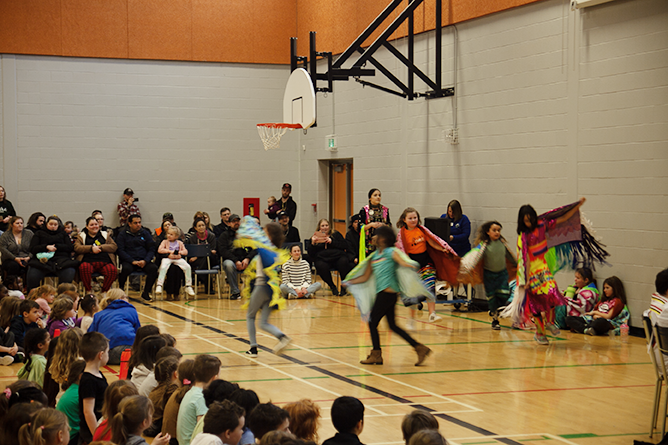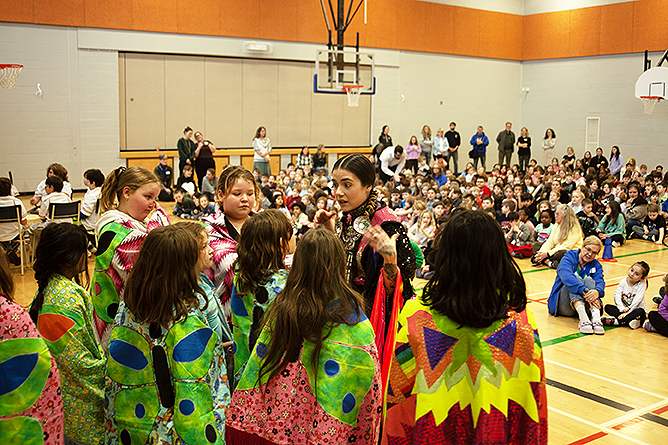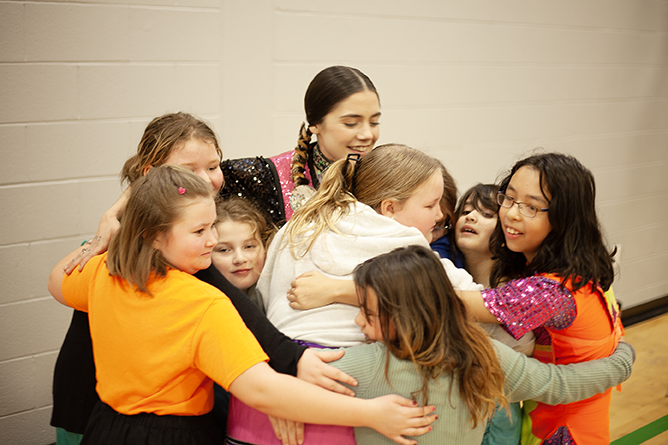

The drum marks time in most music we listen to, inviting us to snap to the beat or tap our feet.
But in the cultures of Indigenous nations, the drum does so much more.
“I was taught by my elders that the drum brings you teaching from when you’re a child, when you’re an adult, when you’re an elder,” said Liam Watson, a Mi’kmaq teacher, singer, and dancer from Metepenagiag First Nation.

“I hope that the non-Indigenous students are able to see that we are still here,” said Brooks. “And I hope it opens up doors for conversations and that they’re able to take something away from it too.”
Brooks’ and Watson’s work with Indigenous students at the school is part of a broader initiative in the district to highlight and mainstream the province’s Indigenous culture.
Watson and Abby Brooks, a teacher and fancy shawl dancer from Sitansisk/St. Mary’s First Nation, teamed up over the last six weeks to impart those teachings to 20 Indigenous students from Gibson-Neill Memorial Elementary School. Their dancing/drumming collaboration culminated in a recital for the school’s students, staff, and faculty on Friday, Feb. 2.
“The tools that our culture offers helps build people up and my hope is that that culture will help build [Indigenous students] up to succeed in what they want to succeed in, whatever that is.”
Percy Sacobie, Wolastoqiyik artist and Director of Education for Sitansisk/St. Mary’s First Nation


The Grade 4 and 5 students, most of whom are from Sitansisk/St. Mary’s First Nation, were divided into two groups, with Brooks instructing the dancers and Watson the drummers. Brooks’s dancers, clad in colourful shawls of Mi’kmaq design, jumped and twirled gracefully to the muscular beats laid down by Watson’s drummers.
“I hope that the non-Indigenous students are able to see that we are still here,” said Brooks. “And I hope it opens up doors for conversations and that they’re able to take something away from it too.”
Brooks’s and Watson’s work with Indigenous students at the school is part of a broader initiative in the district to highlight and mainstream the province’s Indigenous culture.
“Many schools across our district invite dancers in to share dance teachings with Indigenous youth,” said ASD-W’s Sarah Francis of the work done by Brooks and Watson with students at Gibson-Neill.
Francis is the district’s Director of First Nations Education: “Each dance shares the stories and histories of our Nations and the regalia worn is sacred and meaningful to each dancer,” she said. “There was a time when our dances were illegal so to see our youth show their pride in their dancing is incredibly powerful.”
The 1895 Amendment to the Indian Act of 1876
The Indian Act of 1876 prohibited any gatherings at which Indigenous dancing might take place. Bans on these Indigenous cultural celebrations were finally lifted in 1951, but they had a lasting effect on communities across Canada.

“Once the settlers came in, we weren’t allowed to sing, we weren’t allowed to dance,” said Watson. “All these kids’ grandmothers, they weren’t allowed to speak their language. So that’s what we’re trying to bring back. We’re trying to make it normal again.”
The 1895 amendment prohibits the celebration of “any Indian festival, dance or other ceremony.” Powwows, the sun dance and ghost dance are banned under this amendment. Another amendment in 1914 outlawed dancing off-reserve, and in 1925, dancing was outlawed entirely
The Canadian Encyclopedia
Appreciation for Brooks’ and Watson’s mission to both inform and entertain was borne out by the audience’s appreciative applause.
“It’s not easy to perform in front of an audience, especially your peers and your family. So I hope that it sparks something in [Indigenous students] to continue to grow in their culture. For the other students, I hope it helps them gain a greater appreciation for cultural diversity and celebrating cultures and seeing their peers in a different light, not just a regular classmate sitting beside them, that they get to see a little bit into their lives.”
Tracy Stewart, Principal of Gibson-Neill Memorial Elementary School


